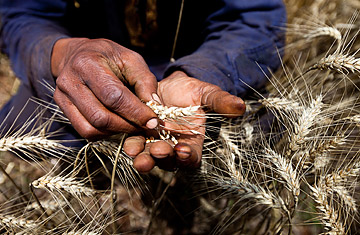
A worker inspects wheat on a farm in Timau, Kenya, on Aug. 19, 2011. East Africa was gripped by a catastrophic drought last year
Climate change might hit us in the most vital place of all — the dinner plate. Why do we care about climate change? Obviously we worry about what warming temperatures might do to the geography of the planet — particularly melting polar ice and raising global sea levels. We fear the impact that climate change could have on endangered species, as warming temperatures speed the already rapid pace of extinction for wildlife that have been pushed to the edge by habitat loss and hunting. We focus on the changing risk of extreme weather, of more powerful storms causing billions of dollars of damage in richer nations — and taking thousands of lives in poorer ones. Sometimes we're simply uneasy with idea that our actions are altering the earth, changing the rhythms of the seasons, shifting weather patterns we've been accustomed to for as long as human beings can remember.
All of that is important — but not as important as the impact that climate change might have on the most vital function of any species: feeding itself. The human population broke the 7 billion mark late last year, and the reason that happened — and the reason we can and will keep growing, barring major changes — is that we've become amazingly proficient at raising food. Our distribution is far from perfect — which is the reason the world is simultaneously home to 1 billion hungry and more than 300 million obese people — and the side effects of large-scale farming can damage the environment. But food production still remains humanity's most amazing accomplishment.
That's why the threat that climate change could mess with agriculture is so scary — and why experts are worried that we're not stepping up to the challenge. In last week's Science, an international group of leading investigators — led by John Beddington, the chief science adviser for the British government — published a call urging policymakers to ensure that agriculture becomes a more vital part of global action against climate change. "Global agriculture must produce more food to feed a growing population," they write. "Yet scientific assessments point to climate change as a growing threat to agricultural yields and food security." In other words, the potential risks to farming are one more reason we need to reduce carbon emissions soon — and the fact that the climate is already changing, and will continue to change, means that we also need to start adapting agriculture to a warmer world immediately.
How exactly could climate change diminish our ability to feed ourselves? Warming alone could do it, with already hot and dry parts of the world — like the American Southwest or the Horn of Africa — predicted to become hotter and drier still. The catastrophic droughts that have gripped Texas and East Africa — leading to a devastating famine in the latter case — this past summer are likely signs of things to come. (And it's not just climate change that should cause us worry there: both regions have a history of megadroughts in the geologic past, before they were widely settled by human beings, which means even the norm may be drier than we think.) While additional carbon in the air may help some plants, warmer temperatures can also retard growth, so extreme heat could lead to greater crop loss.
It's not just drought, though; rain at the wrong time can be disastrous for agriculture as well. That much was obvious during the relentless floods in Pakistan in 2010, which not only killed thousands of Pakistanis but also washed away crops. Those losses helped drive food prices to record highs during the past year — a level from which they're only now beginning to drop. As the atmosphere warms, it can hold more moisture, which means we can expect heavier storms when the rain does fall. Pakistan, too, could be a harbinger of a warmer future.
Warming isn't the only threat to our ability to feed ourselves — it acts in concert with rising population, the growing demand for grain and water-intensive meat, and the civil dysfunction and conflict that often frustrates poor farmers in the developing world. (The ongoing famine in Somalia has as much to do with the civil war there as it does with drought.) That's why scientists are calling for more integrated research as the first step to adapting agriculture to climate change, to ensure that farmers know what's coming — and that they can prepare for it.
No answer will fit all agricultural ecosystems. Problems and solutions will be different in rich countries and poor ones; cool, damp ones; and hot, dry ones. "There are clearly major opportunities this year for scientists to provide the evidence required to rapidly generate new investments and policies that will ensure agriculture can adapt to the impact of climate change," says Bob Scholes of South Africa's Council for Scientific and Industrial Research, who was a co-author of the Science paper.
Smart climate adaptation will also cost money — money that rich nations can spare, but that poor countries, which already face the brunt of climate change, likely can't. If there's one area on which policymakers in the climate arena should focus their effort, it's ensuring that developing nations have the funds — and the expertise — needed to keep feeding themselves as the globe warms. "The window of opportunity to avert a humanitarian, environmental and climate crisis is rapidly closing, and we need better information and tools for managing the trade-offs in how we grow our food and use our resources," says Molly Jahn, dean of the University of Wisconsin-Madison's College of Agricultural and Life Sciences and another author of the Science article. If we hope to thrive in a warmer world — one that's coming — we have no other choice.
